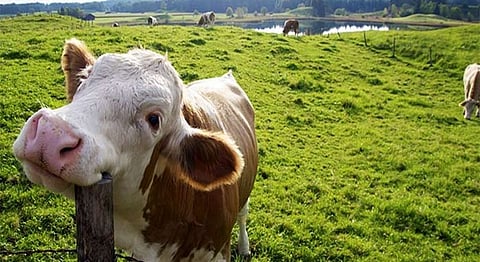
- HOMEGROWN WORLD
- #HGCREATORS
- #HGEXPLORE
- #HGVOICES
- #HGSHOP
- CAREERS
- ABOUT US
- CONTACT US

Switzerland and India are united in their love for the cow. Unlike many Indians though, the Swiss have no qualms about tucking into beef.
The cow is an integral part of the Swiss landscape and an important part of its economy. Their milk goes into making Swiss chocolate and cheese and they are a tourist attraction unto themselves. The zeal with which Indian tourists take pictures of Swiss cows is only matched by westerners clicking away at the cows loitering on Indian roads.
Swiss farmers have come up with numerous ways to show them off – most notably through cow beauty contests and cow fighting competitions. One of the great Swiss mountain traditions is the “Désalpe” or “Alpabfahrt” in autumn when cows descend from their summer Alpine pastures to the plains. They are adorned with flowers and welcomed like heroes by hundreds of people who line the route to catch a glimpse of the bovine procession. The closest Indian equivalent I can think of are the temple chariot processions in southern India. But unlike India, there is no merging of the bovine and divine.
The Swiss love their beef and consume around 28 kilos of beef and veal per person every year compared to a measly 0.5 kilos per Indian. I’ll never forget the sight of seeing a whole cow being barbecued for an entire day at the over 500-year old St Martin fair in the town of Vevey where I used to live. When ready, the entire beast is consumed by fairgoers in a couple of hours. Only a few yards away, the best cows in the region would be paraded by farmers, who, in the old days, would exchange them for other goods.
This adoration of cows along with an appetite for beef is not seen as a contradiction but the natural order of things here. The Swiss express their attachment to the animals in the way they treat them during their short but productive lives. Animal welfare laws are very strict. Cattle cannot be transported more than six hours, must be stunned before slaughter and ritualistic killing practices like Halal are not permitted. Furthermore, the law has provisions to protect the “dignity” of the animal and protect it from “humiliation”. These measures could include providing a bra for cows with udders that are painfully full of milk, or even straightening curved horns that can cause discomfort or injury to the animal.
Some attempts at cow protection have even gone beyond what the law requires. Swiss scientist have conducted a study to test the impact of cowbells on behaviour. At over 100 decibels, the bell noise appears to affect their feeding patterns and pioneering attempts to replace bells with GPS units are underway. Even the Swiss political system of direct democracy has been harnessed in the name of cow welfare. A farmer recently collected over 100,000 signatures to launch a nationwide vote on providing extra subsidies for letting cows keep their horns. It is estimated that only around 10% of Swiss cows have horns due to the practice of removing them when young to avoid accidents and fights.
On learning that I am vegetarian, most of my Swiss friends and colleagues react by saying they are trying to reduce their meat consumption and buying free range meat from local farms. Far from being a defensive reaction, it is a demonstration of an understanding of where one’s food comes and animal welfare issues. If there is any contradiction, it is in India where beef eating and beef eaters are forced underground while cows are often left to fend for themselves by foraging for garbage.
Anand Chandrasekhar is a journalist at swissinfo.ch and is based in Bern, Switzerland.
Representational image via Africa Science News
